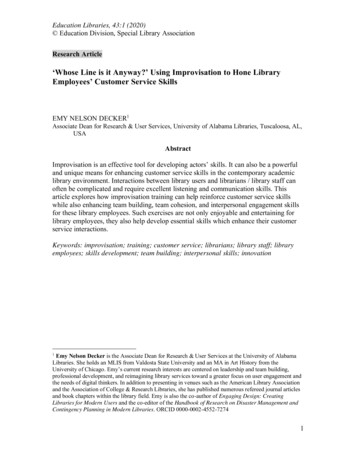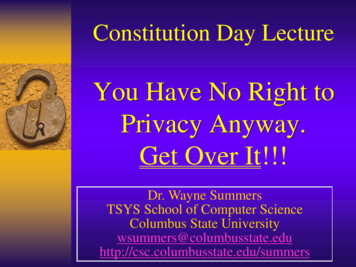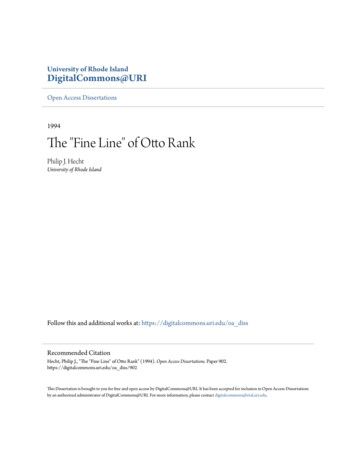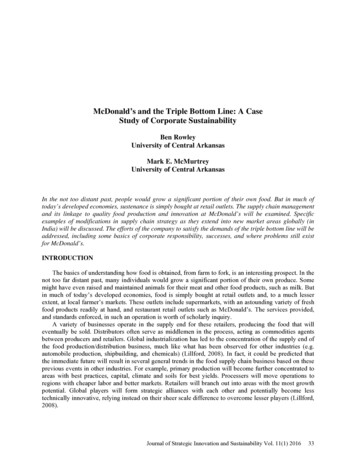
Transcription
Education Libraries, 43:1 (2020) Education Division, Special Library AssociationResearch Article‘Whose Line is it Anyway?’ Using Improvisation to Hone LibraryEmployees’ Customer Service SkillsEMY NELSON DECKER1Associate Dean for Research & User Services, University of Alabama Libraries, Tuscaloosa, AL,USAAbstractImprovisation is an effective tool for developing actors’ skills. It can also be a powerfuland unique means for enhancing customer service skills in the contemporary academiclibrary environment. Interactions between library users and librarians / library staff canoften be complicated and require excellent listening and communication skills. Thisarticle explores how improvisation training can help reinforce customer service skillswhile also enhancing team building, team cohesion, and interpersonal engagement skillsfor these library employees. Such exercises are not only enjoyable and entertaining forlibrary employees, they also help develop essential skills which enhance their customerservice interactions.Keywords: improvisation; training; customer service; librarians; library staff; libraryemployees; skills development; team building; interpersonal skills; innovationEmy Nelson Decker is the Associate Dean for Research & User Services at the University of AlabamaLibraries. She holds an MLIS from Valdosta State University and an MA in Art History from theUniversity of Chicago. Emy’s current research interests are centered on leadership and team building,professional development, and reimagining library services toward a greater focus on user engagement andthe needs of digital thinkers. In addition to presenting in venues such as the American Library Associationand the Association of College & Research Libraries, she has published numerous refereed journal articlesand book chapters within the library field. Emy is also the co-author of Engaging Design: CreatingLibraries for Modern Users and the co-editor of the Handbook of Research on Disaster Management andContingency Planning in Modern Libraries. ORCID 0000-0002-4552-727411
Education Libraries, 43:1 (2020) Education Division, Special Library AssociationIntroductionUser satisfaction with an academic library is normally predicated uponexperiences with librarians and library staff (Note: “library employees” for the durationof this article) (Hossain, 2016). But, these interactions between users and libraryemployees can be complicated and require excellent listening and communication skillson the part of the person receiving the query. In the academic library setting, customerservice interactions frequently begin with a question outside the range of a libraryemployee’s knowledge base or are asked in a way that is ambiguous. Acting, in thetheatrical sense, and the art of providing excellent customer service in the libraryenvironment have many facets in common. In each, practitioners must be able to listen tolearn (without judgement) as to what is being said, respond appropriately, and uphold acertain “keeping in character” demeanor. Just as improvisation training can help actorsbuild acting skills, so too can it help librarians develop interpersonal engagement skillsand aide library employees in adopting the role of the knowledgeable and helpfulinformation guide.Improvisation exercises are an innovative training method in academic libraries,building collaboration that is novel for the participants and, as a by-product, entertainingfor any onlookers. When enhanced customer service and increased team cohesion andcommunication are desired, improvisation exercises reach beyond the traditional teambuilding exercises and offer a true skills-building opportunity, based upon vulnerabilityand trust. Because of these characteristics, customer service training that utilizesimprovisation can also promote increased comfort between colleagues, and a bolsteredconfidence in the trainees’ own ability to provide excellent point-of-need customerservice.This article examines ways that improvisation training activities enhancecustomer service skill-building while improving the academic library user experience. Italso demonstrates how improvisation exercises can help develop communication andcollaboration skills among library employees. Moreover, it provides ready-to-implementexamples of improvisation activities that will enable librarians to augment their existingcustomer service training programs.Literature ReviewThere exists more than one understanding of the term “improvisation.”Improvisation can be defined as a method of marshalling existing resources to cope withunforeseen or unplanned events (Christopoulos et al., 2016). And, in fact, this is whatmany librarians do throughout the course of their day; meet user needs the best they can,as they can. Improvisation, understood by its Greek Theatre or contemporary jazz musicdefinition, is a performance that is not practiced, in which the participants play off oneanother, in the moment (Hadida et al., 2015; Trepanier, 2017). Much of the research inbusiness, organizational development, and even leadership is focused on the formerdefinition and not so much upon the latter (Nisula, 2015). This article offers a uniqueapproach, focusing on the Classical definition of improvisation and its value as apoignant tool toward improving library customer service. Improvisation can be animportant source for developing creativity and can have long lasting effects on2
Education Libraries, 43:1 (2020) Education Division, Special Library Associationparticipants (Fisher & Barrett, 2019). It is an effective and engaging way for individualsto learn about human behavior and for them to develop confidence in conductingthemselves in myriad situations (Hodge & Ratten, 2015).Consider, for example, an improvisation-based training activity that was used byan airline to bolster customer service. Aer Arann, a regional Irish airline, harnessed thepower of improvisation training in order to prepare new and seasoned employees forever-changing customer demands in flight (Daly et al., 2009). The aim of the exercisewas not to turn airline employees into stand-up comedians or actors to entertainpassengers, but instead to help the in-flight crew develop a skillset that would serve themwell when responding to the demands of customers (Stager Jacques, 2013). The airlineemployees’ training portfolio consisted of traditional theatre warm ups such as wordassociation, “conversation playback” - wherein one person listens to their partner intentlyand tries to mimic back exactly what they heard and saw including any physicalmovements or gestures - and improvisation activities that required responses to a scenarioset forth by the trainer. Of particular relevance to front-line service providers are trainingaspects related to “game playing, group expression, approval / disapproval responses,audience sensitivity, and physical movement” (Daly et al., p. 462). Aer Arann employees,like any employees offering forward-facing, branded service, needed to learn how toobserve, listen, “perform” in front of a customer, and trust and expound the work of theircolleagues. Front line service providers cannot carry out their duties in a pre-scriptedfashion; rather, they must conceive and implement responses extemporaneously (YeboahBanin et al., 2016).Aer Arann employees benefitted from improvisation as it taught them toaccommodate unanticipated customer requests. Learning the art of impromptu serviceinteraction also teaches employees to respond quickly and seamlessly to any servicedelivery that goes awry (Daly et al., 2009). As is true for employees in the for-profitsector, library employees can improve their communication skills while lowering theiranxiety about interacting with customers via improvisation training (Scinto, 2014). Thistraining can also teach library employees how to respond spontaneously and effectivelywhile providing excellent customer service.Improvisation training can also help hone skills in librarians who are offeringcustomer service to students by way of instruction. Instruction is core to many librarians’duties. The metaphor of acting, or perhaps, being “on stage”, is certainly not somethingnewly applied to teaching. Teaching and theatre are both crafts that possess a highlikelihood of unplanned interludes and chaotic moments (Shem-Tov, 2018). Everylibrarian who has led instruction sessions has had at least one that did not go asanticipated (Dohe & Pappas, 2017). In the moment, it may not be easy to laugh off, buthaving a skillset for recovery and moving forward can be beneficial. Reading theaudience, taking the instruction session in a slightly different direction, or acknowledgingto a room of silent students, “well, that didn’t quite go as planned,” may garnerempathetic audience participation in the next moment or even the next instruction sessionwith the same class. Further, improvisation allows the instructor to break free of a planthat was not working with an audience and to respond in a way that better fits thesituation (Hadida et al., 2015).As is true of other subject liaison and instruction librarians, education librariansshould be familiar with the importance of strong communication skills for understanding3
Education Libraries, 43:1 (2020) Education Division, Special Library Associationthe perspectives and needs of faculty, students, and staff. Improvisational training, andspecifically the more theatrically-focused, can help education librarians offer enhancedcustomer service to their stakeholders. Instruction and training for patrons on locatingand using K-12 materials, informational tours and orientations to the education libraryspace, and instruction on library resources and services as they relate to classassignments, can all be enhanced by the use of appropriate voice inflection, gestures, and,poise. Improvisational training can enhance the education librarian’s ability to supportand build user interest and engagement, improving the overall effectiveness ofcommunication skills (Worthington, 2017). Nevertheless, it is relatively uncommon tofind librarians with a background in the dramatic arts, and purposeful integration oftheatrical improvisation can work to build these strengths (Worthington, 2017).There are also those employees who offer customer service to the library byserving in a leadership capacity. These librarians not only have to be cognizant of largerinstitutional pressures, but also have to relate to those they are leading. Library leadersneed to be open to alternative ways of problem solving when working within such layersof complexity (Christopoulos et al., 2016). Leadership teams, or perhaps, leadershipteams properly constituted, need to include individuals who exhibit empathy as ahallmark of their leadership ethos (Stager Jacques, 2013; Brooks, 2015). Effectiveimprovisation, like effective leadership, requires strong listening skills, an awareness ofothers, and clear communication (Trepanier, 2017). Improvisation can prepare leaders tobe flexible, creative, adaptable, and better conditioned to respond effectively inunpredictable situations (Tawadros, 2015). Given the pressures felt by library leaders,improvisation exercises can foster improved team dynamics and camaraderie in alandscape where those qualities might not otherwise flow organically (Trepanier, 2017).The highly collaborative nature of improvisation also hones a leader’s interpersonal skillsand increases the likelihood that others will find the person “charming, poised, sociallyadept, approachable, and rewarding to deal with” (Ratten & Hodge, 2016, p.152). Theconcept of “vulnerability” echoes through these qualities as well. It would be easier togarner library employees’ participation in a meeting and encourage them to share theirfeelings if a leader first shared their own.Perhaps the easiest facet of improvisation to recognize and to incorporate intodaily library practice is what is known as “Yes, and” (Moshavi, 2001). The “Yes, and” technique refers to the practice of an actor receiving information and accepting it inthe affirmative and then adding “and” as a way of continuing and building upon theinteraction or scene. In improvisation training, a participant could easily shut down theinteraction by denying what the other has just said, but by affirming and offering moreinformation, the opportunity to develop a scene comes to fruition. Dohe and Pappas(2017) implore library employees to say “yes, and” to colleagues and reflect upon theways that such a phrase - taken from the art of improvisation - can serve as an opening tofluid co-creation and to the building of ideas. In an education library setting, whereexploration is part of the process, the concept of “yes, and” could be employed as apatron is exploring K-12 kits and materials and is working to develop assignmentsbolstered by the use of such resources. The education librarian can first affirm thepatron’s discovery (the “yes” part) and then use “ and” to help him or her incorporatecontemporary research methodologies, current pedagogical trends, and best practices ininstructional development into their lesson design.4
Education Libraries, 43:1 (2020) Education Division, Special Library AssociationFramework for ImplementationUsing improvisation as a method of training is an effective way to help libraryemployees hone their customer service skills. The author implemented improvisationtraining in a former position at an academic library. Trainees consisted of 18 libraryemployees, all of whom worked in forward-facing roles within the public servicesdepartment. While training details are outlined in the chart that follows, it is important tonote that improvisation activities are limited only by the trainer’s imagination. Indeed,some of the pleasure offered by this method of training may come from developing thescenarios. That said, in today’s hectic library setting, a conceptual framework for settingup such activities may prove helpful in getting started and stimulating creativity, and thisprovides a framework for that beginning.The facilitator’s role during training is to pitch the improvisation topic, not tocoach those performing the improvisation or to guide them in any way. The learningexperience takes place when the participants listen to and play off one another; they arenot receiving instruction or direction from the facilitator. Only in the case that theimprovisation routine has stagnated would the facilitator want to re-engage with thosewho are role-playing (Dudeck & McClure, 2018).Table 1 provides examples of specific improvisation activities, created by theauthor, that can help accomplish library customer service training goals. These may beadapted to fit the training needs of other academic libraries. Tracing the first example inthe chart will elucidate how an improvisation activity can enhance customer serviceacumen. The prompt the author pitched to a randomly selected dyad from the group of 18library employees was, “a sandwich shop employee must convince the CEO of thesandwich company to offer a never-been-made-before and very unlikely flavour ofsandwich.” One library employee, playing the role of the sandwich shop employee, andthe other in the role of CEO – had to think quickly and play off each other in order towork their way through this given hypothetical situation. The participants immediatelyrecognized the dynamic of the employee-boss relationship (a common trope inimprovisation exercises) and took that as a starting point. The participant in the role ofthe sandwich artist worked quickly to come up with a thirty second “elevator speech” topitch her sandwich idea. The library employee acting in the CEO role had a choice tomake about what kind of “big boss” she wished to portray: one who was benevolent,interested, and puts her employees first, or a harried, disinterested, “I don’t have time foryou” boss – or, something in between. She went with the more encouraging option andlistened to the sandwich artist make her pitch. Their back and forth banter entertained theauthor and the 16 colleagues watching as they awaited their own turn, and the sandwichthat was pitched in the scenario included the unlikely ingredient of frog legs.The open-ended nature of improvisation requires instantaneous decision-makingand an embodiment of the character. Whatever is first on the participant’s mind is likelywhat will come out in the exercise. It is not a stretch to recognize how the employee-bossjuxtaposition is relatable to an employee-library user interaction. Library users come intothe library with a wide variety of moods and personalities and it’s incumbent upon thelibrary employee to reach out and offer excellent customer service, nevertheless. Beingable to quickly read the present mindset of the user allows the library employee to offer5
Education Libraries, 43:1 (2020) Education Division, Special Library Associationthem the kind of service they need in that moment. In this way, having to make asandwich pitch teaches the library employee requisite skills for how to think quickly,adapt to the scenario, and then promote helpful and targeted resources during a briefencounter with a user. It also fosters creativity in thinking beyond the usual “canned”answers and develops a keen ability to problem-solve on the spot.Table 1. Examples of Improvisation ActivitiesImprovisation ScenarioA sandwich shop employee mustconvince the CEO of the sandwichcompany to offer a never-beenmade-before and very unlikelyflavour of sandwich.Interview with a world-classtrampoline champion (or otherunlikely premiere athlete)A couple is trying to get past theTSA with weird (but innocent)items in their carry-on bagsThere is a zombie apocalypse andyou and your friend need to gothrough your survival bags toensure that you have all you willneed.The members of a committee aretrying to convince the President/Principal of the school to redesignthe current mascot’s appearanceAn artist is working to convince agallery that they need specialaccommodations for an upcomingshow, but the artist is being veryevasive about the materials andnature of the show. Galleryemployees are trying to figure outappropriate accommodations.Former cheerleaders from rivalschools have to work together todevelop another school’smathematics curriculum.Number ofApplicable Skills DevelopedParticipants2Marked by brevity, the library employeecan learn from this type of improvisationexperience how to pitch helpful andtargeted resources to the user.22-322-43-42Related to a traditional-style “referenceinterview,” participants in this activitycan glean skills in delving into user needsin areas where they are not expert.Teaches patience in understanding userrequests when they may at first seemunusual, or when users ask for specificresources or items they may mistakenlybelieve they need when an easier startingpoint may be to ascertain their actualinformation need.Participants learn how to work with auser to check that they have all of therequisite materials for a class or aresearch assignment before they walk outof the library.Valuable in a group or committee worksetting. Library employees can learn howto work together to form a consensus anduse the powers of presentation andpersuasion to promote their case tostakeholders.Teaches participants how to get only thenecessary and required information froma patron in order to fulfil a requestwithout violating their privacy. Can behelpful in developing sensitivity toLGBTQ , ADA, etc. scenarios.Can help frame methods for workingwith colleagues – even those in otherareas or with different approaches toward a common goal of assisting apatron.6
Education Libraries, 43:1 (2020) Education Division, Special Library AssociationParticipants in improvisation customer service training have to react together in themoment, with no preparation time, to deliver a response that directly addresses theprompt as it is given. Improvisati
Libraries. She holds an MLIS from Valdosta State University and an MA in Art History from the University of Chicago. Emy’s current research interests are centered on leadership and team building, professional development, and reimagining library services toward a greater fo











